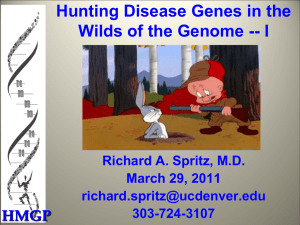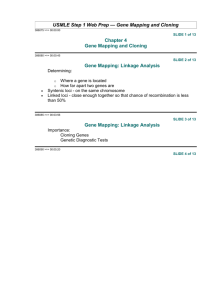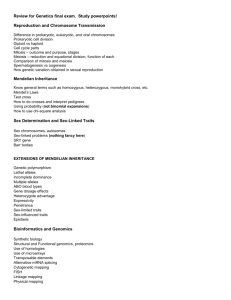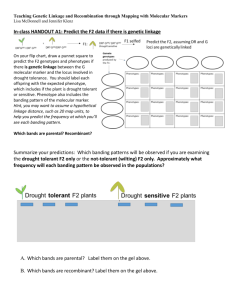BE183Lt3LinkageMapping
advertisement
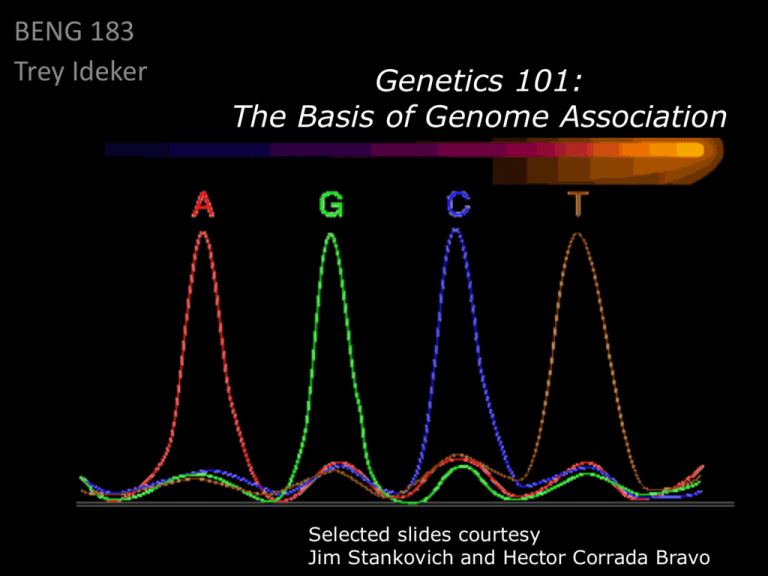
BENG 183 Trey Ideker Genetics 101: The Basis of Genome Association Selected slides courtesy Jim Stankovich and Hector Corrada Bravo Review of Mendelian genetics • Gregor Mendel analyzed the patterns of inheritance of seven pairs of contrasting traits in the domestic pea plant. As an example pair: • P1: He mated a plant that was homozygous for round (RR) yellow (YY) seeds with one that was homozygous for wrinkled (rr) green (yy) seeds. • F1: All the offspring were dihybrids, i.e., heterozygous for each pair of alleles (RrYy). • All seeds were round and yellow, showing that the genes for round and yellow are dominant. Mendelian genetics (2) • F2: Mendel then crossed the RrYy dihybrids. • If round seeds must always be yellow and wrinkled seeds must be green (linked genes), then this would have produced a typical monohybrid cross • But in fact, the F2s had seeds with all combinations: Round-yellow Round-green Wrinkled-yellow Wrinkled-green 9/16 3/16 3/16 1/16 RY ry RY RRYY RrYy ry RrYy rryy Recombinants Recombinants Percentage of recombinants = 50% Mendel’s Rule of Independent Assortment The inheritance of one pair of factors (genes) is independent of the inheritance of the other pair. • In other words, the percentage of recombinants is 50% • Today, we know that this rule holds only if one of two conditions is met: – The genes are on separate chromosomes – The genes are widely separated on the same chromosome. • Mendel was lucky in that every pair of genes he studied met one requirement or the other!!! • In fact, the rule does not apply to many matings of dihybrids. In many cases, two alleles inherited from one parent show a strong tendency to stay together as do those from the other parent. • This phenomenon is called linkage. Genetic distance in centiMorgans • The percentage of recombinants formed by F1 individuals can range from 0-50%. • 0% is seen if two loci map to the same gene. • 50% is seen for two loci on separate chromosomes (independent assortment). • Between these extremes, the higher the percentage of recombinants, the greater the genetic distance separating the two loci. • The percent of recombinants is arbitrarily chosen as the genetic distance in centimorgans (cM), named for the pioneering geneticist Thomas Hunt Morgan. Genetic recombination is due to the physical process of crossing-over Mating occurs AFTER all of this Genetic Maps • Chromosome maps prepared by counting phenotypes are called genetic maps. • Maps have been prepared for many eukaryotes, including corn, Drosophila, the mouse, and tomato. • Controlled matings are not practicable in humans, but map positions are estimated by examining family trees (pedigrees) • A genetic map of chr. 9 of the corn plant (Zea mays) is shown on the right with distances in cM. • Note distances >50cM. How? Example • • • Corn plants are scored for three traits: C/c colored/colorless seeds Bz/bz bronze/non-bronze stalk Sh/sh Smooth/shrunken The following F1 heterozygote self-crosses are performed: (C/c; Bz/bz) X (C/c; Bz/bz) 4.6 cM (Sh/sh; C/c) X (Sh/sh; C/c) 2.8 cM What does the genetic map look like? Gather more data– now can the map be determined? (Sh/sh; Bz/bz) X (Sh/sh; Bz/bz) 1.8 cM Problems with genetic maps • Recombination frequency underestimates genetic distance for larger distances, due to higher order cross-over events, i.e. double and triple crossovers between markers This is overcome with 3 pt. mapping (homework) • The probability of a crossover is not uniform along the entire length of the chromosome. – Crossing over is inhibited in some regions (e.g., near the centromere). – Some regions are "hot spots" for recombination (for reasons that are not clear). Approximately 80% of genetic recombination in humans is confined to just one-quarter of our genome. • In humans, the frequency of recombination of loci on most chromosomes is higher in females than in males. Therefore, genetic maps of female chromosomes are longer than those for males. Genetic vs. physical maps • The loci in genetic maps are simply parts of the DNA molecule that create the observed phenotype. • Knowing the DNA sequence (or at least the ordering of contigs) directly gives the order/spacing of genes. • Maps drawn in this way are called physical maps. • As a very rough rule of thumb, 1 cM genetic distance ~ 1 MB of DNA. Gene linkage mapping • Tries to find a common inheritance pattern between a chromosomal region/marker and a disease phenotype • Requires genotyping on large, multigeneration pedigrees • Coarse mapping with sparse markers <10 Mb • At greater distances linkage generally does not occur due to frequent recombination events • At lesser distances all loci are typically linked and thus are indistinguishable from one another Linkage analysis in a 3 generation pedigree Solid red indicates the disease phenotype; dot means carrier The gel is the result of RFLP analysis—note variants 1 and 2 Is this a recessive or dominant gene? Autosomal or sex linked? What is the penetrance? This is Pr(disease phenotype | disease genotype) Autosomal dominant linkage RFLP: 1/1 1/2 1/2 1/2 2/2 Disease No Disease 2/2 2/2 2/2 2/2 2/2 1/2 2/2 2/2 Computing a Log Odds (LOD) score • From the last slide: 3 affected offspring carry RFLP1, while 1 affected and 5 unaffected offspring do not carry it. • If the two loci (RFLP1 and the disease gene) are unlinked, the probability of the above observation is (0.5)9 = 0.002 • If the two loci are in fact linked and the chance of crossover is 10% (called the recombination fraction), the probability of the observed pattern of disease is (0.9)8(0.1)1 = 0.04 • For each individual we are computing: Pr(D|Model) = Pr(disease state | RFLP1 state ^ linkage) Pr(D|Random) = Pr(disease state | RFLP1 state ^ non-linkage) Computing a LOD score Pr( D | M ) Pr( D | R) LOD log 10 children children children log Pr( D | M ) log Pr( D | R) children • In the prev. example the LOD score is log10(0.04 / 0.002) = 1.3 • A LOD > 3.0 is generally considered significant • Alternatively, parametric analysis models modes of inheritance (domnt,recssv,x-linked,etc.) Table of LOD scores If recombination fraction is unknown, optimize this parameter Recombination Fraction (%) 0 10 20 30 40 Family A 2.7 2.3 1.8 1.3 0.7 Family B -∞ 1.0 0.9 0.6 0.3 Total -∞ 3.3 2.7 1.9 1.0 Box 12.1 from Primrose and Twyman Gene association mapping • Also looks at common inheritance but in populations of unrelated individuals – No pedigrees required • Fine mapping with dense markers at least every 60 kb • Beyond this distance loci are generally in linkage equilibrium • Also called Linkage Disequilibrium mapping • Can be used in conjunction with the coarser grained map of linkage analysis • Can also be used alone with a genome-wide map of markers, this is called Genome-Wide Association Analysis (GWAS) How to conduct a GWAS • Obtain DNA from people with disease of interest (cases) and unaffected controls. • Run each DNA sample on a SNP chip to measure states of ~1,000,000 SNPs. • Identify SNPs where one allele is significantly more common in cases than controls. • We say this SNP is associated with disease. • What are some interpretations of this? Haplotype mapping • A haplotype is a pattern of SNPs in a contiguous stretch of DNA • Due to linkage disequilibrium, SNPs are typically inherited in discrete haplotype blocks spanning 10-100kb • Greatly simplifies LD analysis, because rather than screen all SNPs in a region, we just need to screen a few and the rest can be inferred • A complete human haplotype map is still underway, but the latest is available in the HapMap project Example haplotype map Figure 12.4 from Primrose and Twyman LD mapping elucidates our evolutionary origins • In Northern European populations, LD extends for ~60kb • In a Nigerian African population, LD extends for ~5kb, a much shorter distance • What do we conclude from these findings? Logistic Regression • The log odds is also called the logit function. • The logistic function is the inverse logit: p z logit p log 1 p 1 -1 p logit z z 1 e æ p ö z = log ç ÷ = b0 + b1 x1 è 1- p ø 1 p= -z 1+ e The input is z and the output is ƒ(z). The logistic function is useful because it can take as an input any value from negative infinity to positive infinity, whereas the output is confined to values between 0 and 1. The variable z represents the exposure to some set of independent variables, while ƒ(z) represents the probability of a particular outcome, given that set of explanatory variables. P x1 A GWAS for Warfarin Response Cooper GM, et al., “A genome-wide scan for common genetic variants with a large influence on warfarin maintenance dose,” Blood 112: 1022-1027 (2008). WHAT MIGHT BE THE PROBLEM? Linkage and LD analysis in tandem Figure 12.2 from Primrose and Twyman Sensitivity, specificity, odds ratio, likelihood ratio, and all that…

